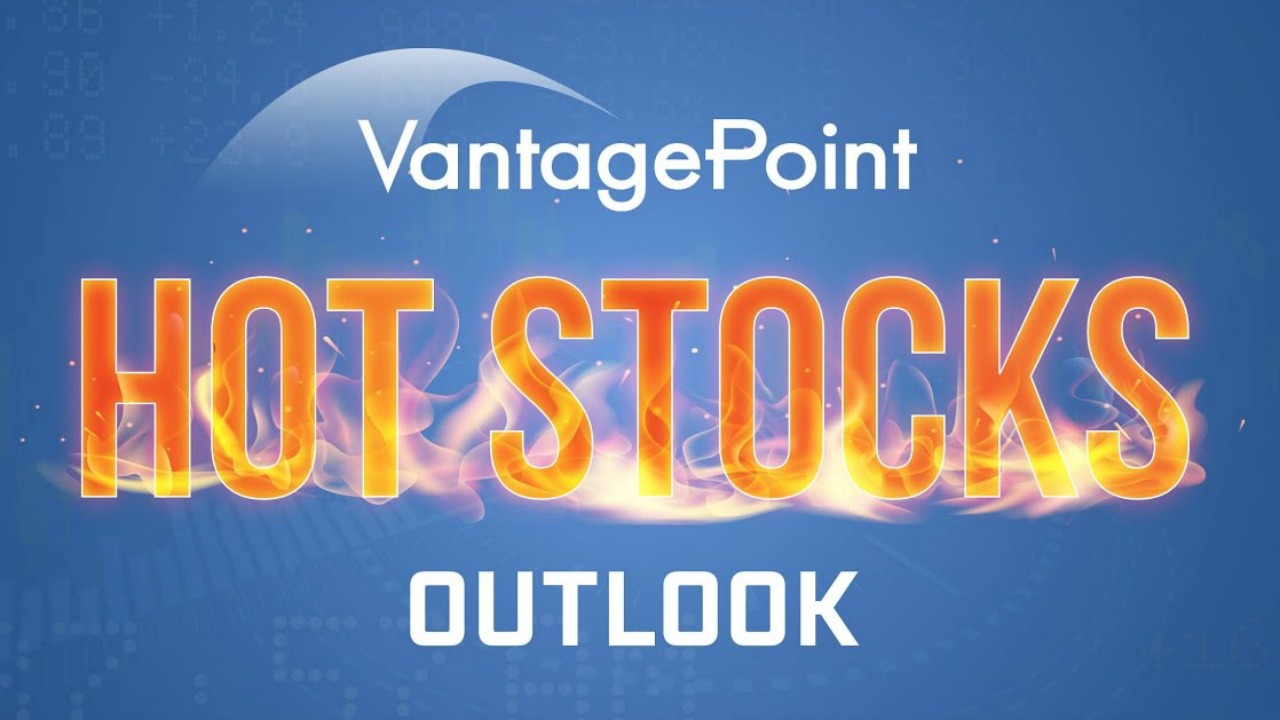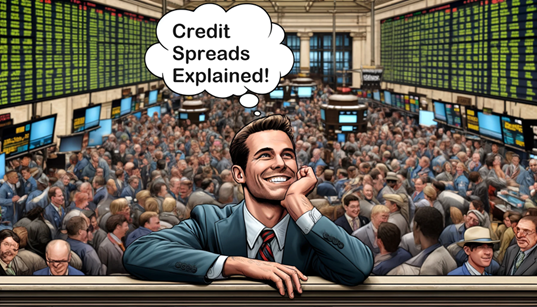
An Options contract is an agreement between two parties to facilitate a potential transaction on a stock at a preset price, known as the strike price, before the contract expires. Think of it as a contract for a future deal. If you buy an Options contract, you’re securing a price for a stock you might want to buy or sell later. It’s like making a reservation at your favorite restaurant; you’re securing your spot whether you decide to go or not.
Options come in two main flavors: Call Options and Put Options.
– **Call Options** allow you to buy a stock at a fixed price. If you believe a stock’s price will go up, you might buy a call option. It’s like saying, “I bet the price of this toy will go up, so I’ll agree to buy it at today’s price, but pay for it later.”
– **Put Options** give you the right to sell a stock at a predetermined price. If you think a stock’s price will fall, you might buy a put option. This is akin to saying, “I bet the price of this toy will go down, so I’ll agree to sell it at today’s price, even if I do it later.”
Options trading is important because it adds flexibility to investing/trading. Unlike simply buying stocks, Options let you make money whether the stock market is going up, down, or sideways. Options can also be used to reduce risk in your portfolio, allowing you to hedge against potential losses.
For new traders, Options offer several benefits:
**Lower Initial Investment**: Options allow you to control a lot of stocks for a fraction of the price of actually buying the stocks outright.
**Flexibility**: With the variety of strategies available, Options trading can be tailored to match your risk tolerance and market view.
**Risk Management**: Options can help protect your investments from market downturns when used correctly.
**Potential for High Returns**: While Options can be risky, they also offer the potential for significant returns, especially if you predict the market’s movement correctly.
Options trading opens a new realm of possibilities for investors, offering a unique way to participate in the stock market’s potential for growth while managing risk. Whether you’re looking to speculate on stock price movements, hedge your portfolio, or generate income, understanding Options is a powerful tool in your investing toolkit.
Options require some education to understand the multitude of different strategies that can be created. The strategy of credit spreads that I will be explaining today is considered to be an intermediate level Options tactic. To grasp this concept, it is essential that trader comprehend the basics of Options trading which I have written about extensively on this blog.
I recommend studying these four basic strategies to develop mastery of this exciting subject matter:
What makes Options trading unique is that Options are time sensitive deteriorating assets.
An Option is a contract that gives the buyer the right, but not the obligation, to buy or sell an underlying asset at a predetermined price (strike price) before or at a specific date (expiration date). This feature makes Options inherently time-sensitive, as their value is closely tied to the amount of time remaining until expiration. The closer an option gets to its expiration date, the less time there is for the underlying asset to move in a direction that would make the option profitable to exercise. This time sensitivity affects both how Options are priced and how they are used in investment strategies.
The diagram below describes the four most basic Options tactics. What is crucial to understand whenever trading Options is the difference between buying an option and creating or selling an option. This distinction is what opens the floodgates of possibilities.
A buyer of an option has a right to buy or sell the asset at the agreed upon price, in exchange for a premium payment they make today.
The creator or seller of the option is receiving the premium payment today and is obligating themselves to “make good” on the option they have created should the buyer exercise the Options contract.
The distinction that I like to make is to draw a comparison to any insurance product you ever utilize as they are all identical to Options contracts. When you buy insurance, you pay a premium and you have an agreed amount of protection.
When you sell insurance, you receive the premium, and are creating obligations that might need to be fulfilled.
Most traders become comfortable buying Options because of their limited risk qualities. On paper it sounds great and very appealing to have limited risk and unlimited reward potential. However, if you ignore the reality that Options are deteriorating assets most Options BUYERS will not succeed.
Sophisticated traders have learned that by creating (selling) Options they can put the probabilities very much in their favor as long as they learn to offset their risk as much as possible.
The diagram below highlights the four basic Options strategies along with their desired directionality as well as isolating whether it is a right or an obligation. By learning to mix and match these tactics together a trader can create a limited risk, high profit income producing asset like the credit spread strategy.
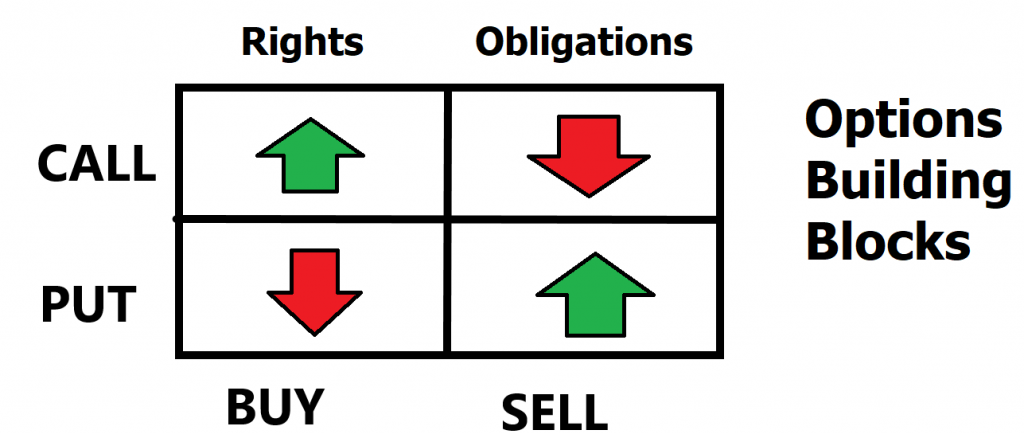
A credit spread, when implemented correctly, involves selling an Option at a certain strike price while simultaneously buying an Option with the same expiration date but a different strike price, resulting in a net credit to the trader’s account. This strategy limits the risk to the difference between the strike prices minus the credit received, ensuring that potential losses are capped. It is considered a high percentage profit and income-producing asset because the trader profits if the underlying asset stays within a predicted range, making it a popular choice for generating consistent income with a defined risk profile.
The beauty of Options trading is that it allows a trader to create strategies that are profitable based upon the stock being between a range of prices at a particular date in time.
Options credit spreads are a sophisticated trading strategy utilized in the Options market, allowing traders to capitalize on the expected stability or minor fluctuations in a stock’s price. This strategy involves simultaneously buying and selling Options contracts of the same class (calls or puts) on the same underlying security with different strike prices or expiration dates. The “credit” in the name comes from the initial net premium received by the trader, as the option sold is typically more expensive than the option bought, resulting in an upfront net income. This strategy limits the potential profit to the net premium received while also capping the maximum loss to the difference between the strike prices minus the net premium received. By carefully selecting the strike prices and expirations, traders can construct a spread that aligns with their market outlook, risk tolerance, and investment objectives, making it an important tool for portfolio management and speculative trading.
Here is a simple visual diagram that explains the methodology of a credit spread using call options:
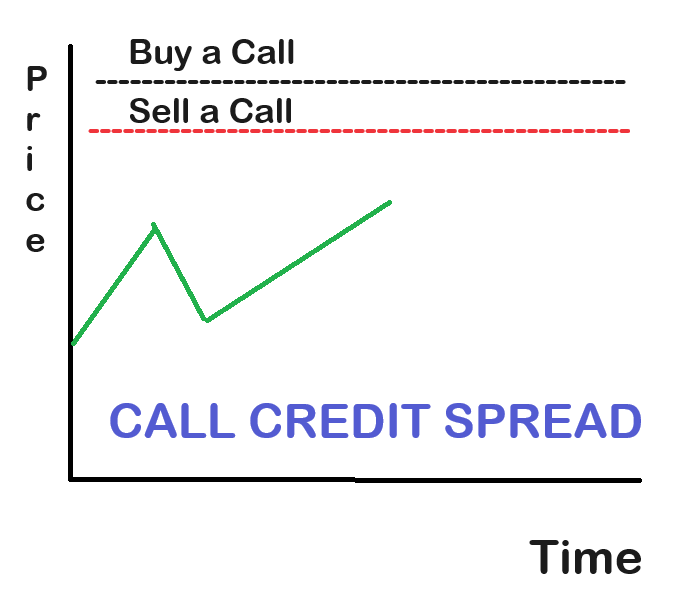
A call credit spread is sometimes also referred to as a Bear Call spread. A trader implementing this tactic is obligating themselves to be short the market at the dotted red line. Simultaneously they have the right to be long on the market at the dotted black line. By implementing this tactic, they have received more money than they have paid, thus the name “credit spread.” Lastly the risk on this trade is capped as the difference between the red dotted line and the black dotted line (the strike prices), less the premium received.
Credit spreads are particularly profitable in environments where the market is expected to be range-bound or moderately directional within a well-defined range. For instance, a bull credit spread (selling a put and buying a lower strike put) profits when the underlying security stays above the higher strike price of the sold option, making it suitable for moderately bullish environments. Conversely, a bear credit spread (selling a call and buying a higher-strike call) is profitable in mildly bearish markets, as it benefits when the security remains below the sold call’s strike price. These strategies thrive on time decay (theta) and minor price movements, making them ideal in low volatility environments where significant price swings are unlikely. However, in high volatility environments with sharp and unpredictable price movements, credit spreads can become unprofitable. The risk of the underlying asset moving against the trader’s position increases, potentially leading to the maximum loss scenario. Therefore, understanding the market environment and volatility is crucial for traders utilizing credit spreads to enhance their chances of success.
This can be implemented on the downside of the market as well. Sometimes these are referred to as Bull Pu Spreads. A trader who thinks that a market will not go below a certain level will sell a put option and obligate themselves to a long position at that strike price. In exchange they receive a premium payment immediately. Simultaneously they are buying a lower strike price put option, giving them the right to be short on the market. This also creates a limited risk trade. If the market remains above the dotted red line, both Options will expire worthless, and the strategy produces income for the trader.
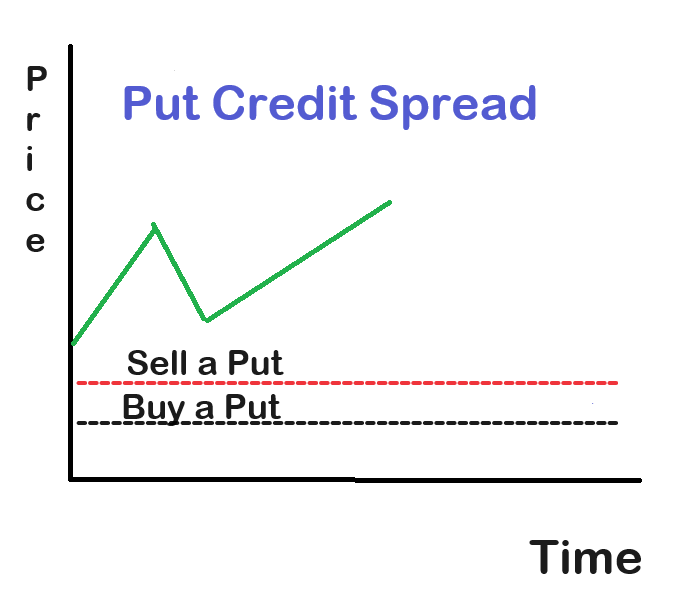
It can pay huge dividends to work and make sure you understand the risk/reward profile of this strategy as credit spreads are often used in any market where Options are traded. That includes stock, forex, commodities, futures, and cryptocurrencies.
I always suggest to traders to make sure they understand the worst-case scenario before entering into any trade. With credit spreads the worst-case scenario is always the difference between the strike prices, less the premium received. ALWAYS. Hard stop. When you genuinely understand this idea and concept it opens up your portfolio towards income generation possibilities.
Let me explain.
Let’s say $XYZ stock is trading at $105.
I am not expecting a huge amount of activity in $XYZ over the next 30 days.
I look at 30 days till expiration primarily because that is when Options deteriorate the fastest. However, this strategy can be implemented on any time frame.
Let’s look at the two primary aspects of this strategy to highlight an understanding of risk.
SELL to OPEN the $100 PUT
BUY To OPEN the $95 PUT
These are the two legs of the put credit spread.
Worst case scenario if $XYZ goes to zero, you are obligated to BUY $XYZ at $100, and you have the simultaneous right to sell $XYZ at $95. That means that the worst case will ALWAYS be the difference between the strike prices of $5 less the amount of credit you received for establishing the position. ALWAYS. Hard Stop.
Best Case Scenario will occur at any price above the $100 strike price because all Options will expire worthless. So, in this scenario your maximum profit will always be the difference in premium that you paid versus the difference in premium that you received. ALWAYS. Hard Stop.
Graphically, it will look like this:
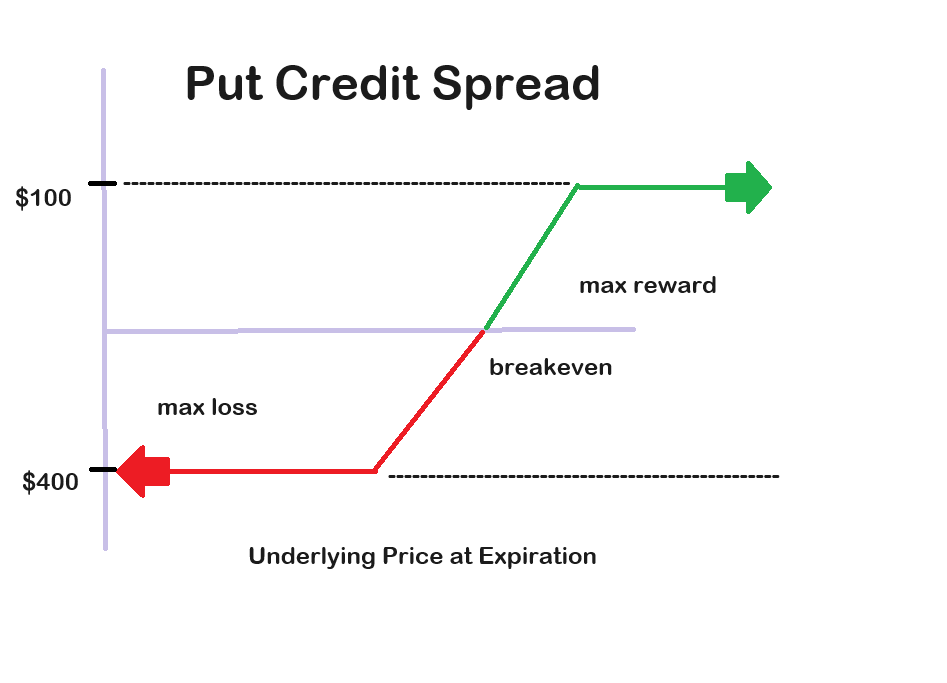
Initially, you might look at the risk/reward profile and think to yourself “this is a bad trade because my risk is $4, and my reward is only $1.” This is where an appreciation of probabilities comes into play because what if I tell you that the probabilities of success are over 70% and the risk of a worst-case scenario is less than 10%?
There is risk in this strategy, but it is very clearly defined.
Also, the % return on is massive when compared to the margin requirement to implement the strategy. Most brokers will require that you have $500 in your account to establish this trade. Now if you make $100 on that requirement in 30 days that is a20% return on margin. Annualize those figures and you will understand why credit spreads are so popular.
Let’s apply this same tactic but using call Options instead. In this scenario $XYZ is trading at $105. I am not expecting much upside.
Let’s look at the two primary aspects of this strategy to highlight an understanding of risk.
SELL to OPEN the $110 CALL
BUY To OPEN the $115 CALL
These are the two legs of the credit spread.
Worst case scenario is always the difference between the strike prices.
In this strategy if $XYZ explodes higher, even as high as infinity, you have agreed to SELL $XYZ at $110 and you have agreed to buy it back at $115. That means your risk, in a worst-case scenario is $5 per share, which is the difference between the strike prices, less the premium you receive. ALWAYS. Hard stop.
Best Case Scenario will occur at any price below the $110 strike price because all Options will expire worthless. So, in this scenario your maximum profit will always be the difference in premium that you paid versus the difference in premium that you received. ALWAYS. Hard Stop.
Graphically, it will look like this:
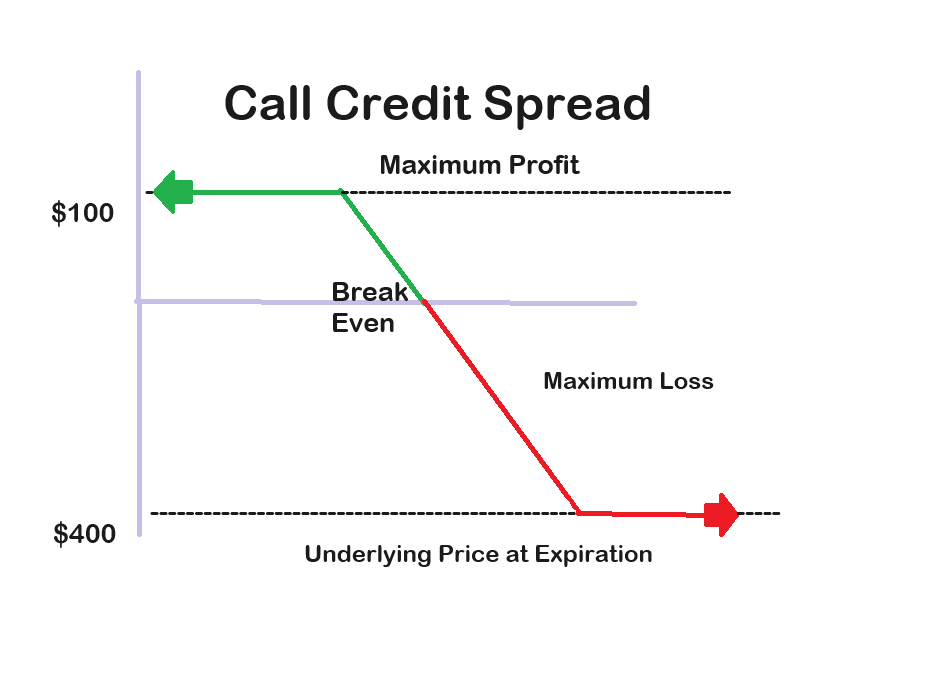
Credit spreads, like all Options strategies, come with inherent risks. The most significant risk is the potential for maximum loss if the market moves unfavorably beyond the strike price of the sold option. You always will theoretically have more risk, than potential reward. But the risk is capped and always very clearly defined.
Effective risk management is crucial in Options trading to mitigate potential losses. One strategy is to set stop-loss orders to automatically close positions once a certain level of loss is reached, preventing further deterioration of equity in your trading portfolio.
New traders often fall into several common pitfalls with put credit spreads. Overleveraging, or risking too much on a single trade relative to the total trading capital, can lead to significant losses from minor market movements. Ignoring or misjudging the impact of implied volatility on option prices is another mistake, as it can affect both the premium received and the price at which the spread can be closed. Lastly, a lack of a clear exit strategy before entering a trade can trap traders in losing positions, highlighting the importance of having predefined criteria for both taking profits and cutting losses.
Option trades can be put on at any time and they can also be liquidated at any time. You are not required to hold on to a position till expiration. The beauty and flexibility of credit spreads is what makes them to be very attractive in that for them to be profitable they simply must stay away from the strike price that you sold.
Usually, a trader will graduate towards exploring credit spreads when they recognize the problem of just being net long Options due to the continuous time decay in option premium. Options historically decay the fastest in their final 30 days till expiration. Utilizing a credit spread allows traders to offset the super bullishness of a bull with the super bearishness of a bear and simply collect the insurance premium. This strategy can and will work wonders if you choose your strike prices correctly in a non-trending market.
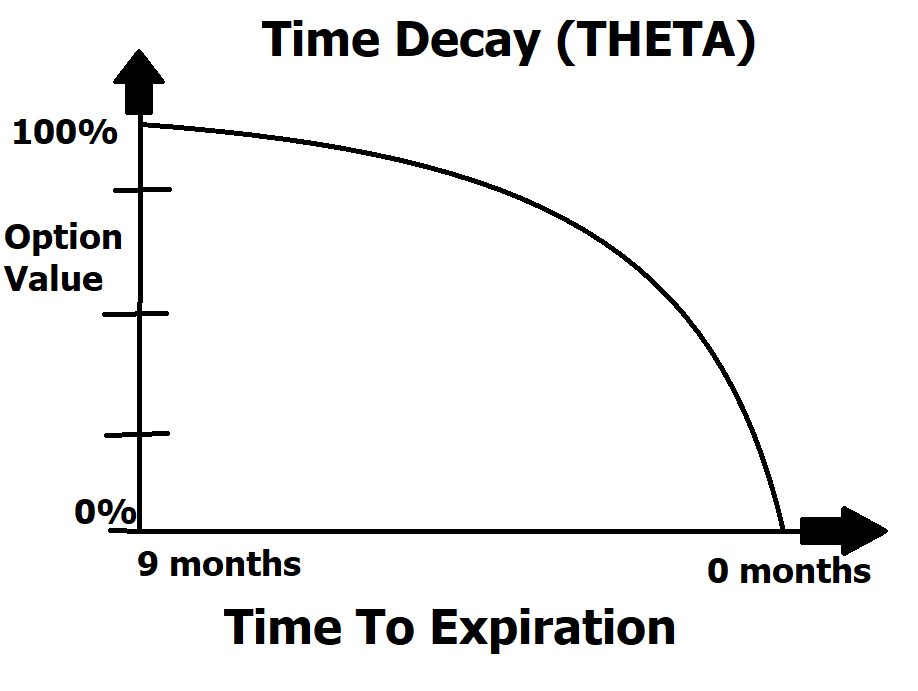
The concept of time decay, or theta, is crucial to understanding why Options are considered deteriorating assets. Time decay refers to the rate at which the value of an option erodes as the expiration date approaches. This erosion is not linear; it accelerates as the expiration date gets closer. The rationale behind time decay is that with less time remaining, there is a smaller probability of the underlying asset moving in a way that would make the option more valuable. Therefore, all else being equal, an option loses value as time passes, making it a deteriorating asset.
The rate of time decay varies among different Options. It is influenced by factors such as the option’s moneyness (its intrinsic value), volatility of the underlying asset, and the amount of time until expiration. Generally, at-the-money (ATM) Options experience the highest rate of time decay, while in-the-money (ITM) and out-of-the-money (OTM) Options have a slower rate of decay.
For new Options traders, Options offer several benefits:
Lower Initial Investment: Options allow you to control a lot of stocks for a fraction of the price of actually buying the stocks outright.
Flexibility: With the variety of strategies available, Options trading can be tailored to match your risk tolerance and market view.
Risk Management: Options can help protect your investments from market downturns when used correctly.
Potential for High Returns: While Options can be risky, they also offer the potential for significant returns, especially if you predict the market’s movement correctly.
Options trading opens up a new realm of possibilities for investors, offering a unique way to participate in the stock market’s potential for growth while managing risk. Whether you’re looking to speculate on stock price movements, hedge your portfolio, or generate income, understanding Options is a powerful tool in your investing toolkit.
Power Traders use VantagePoint’s A.I. verified Support and Resistance zones to provide guidance.
Here is a chart of Apple ($AAPL). Over the last 3 months a consistent winning strategy has been to sell call credit spreads as the market has fallen. Over the last month as $AAPL has consolidated selling put credit spreads has also been profitable.
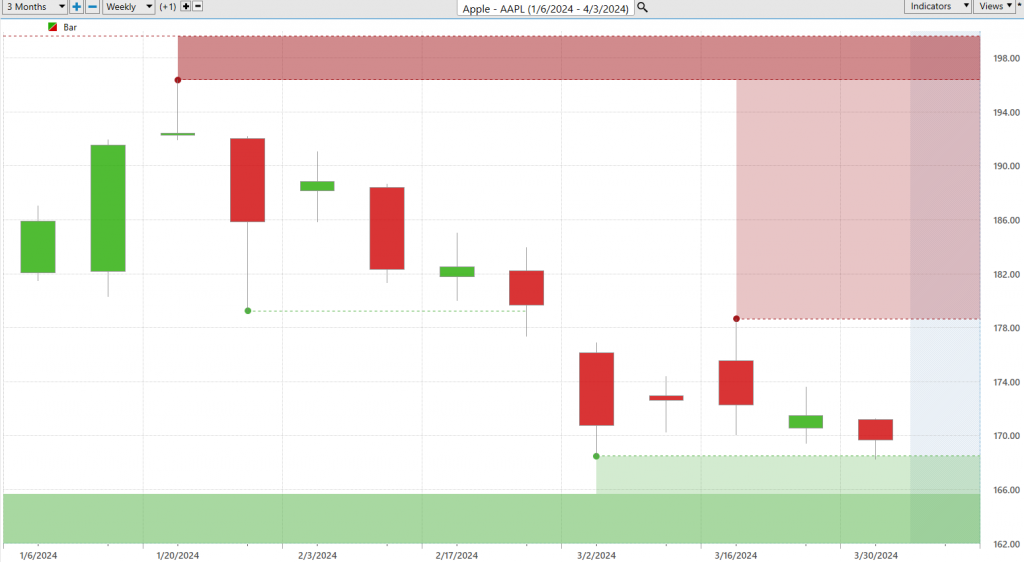
For PUT CREDIT SPREADS traders would want to focus on a rising or sideways trend. A perfect example of that is the SPDR SPY ETF ($SPY) with VantagePoint’s A.I. predictive blue line which clearly highlights the trend.
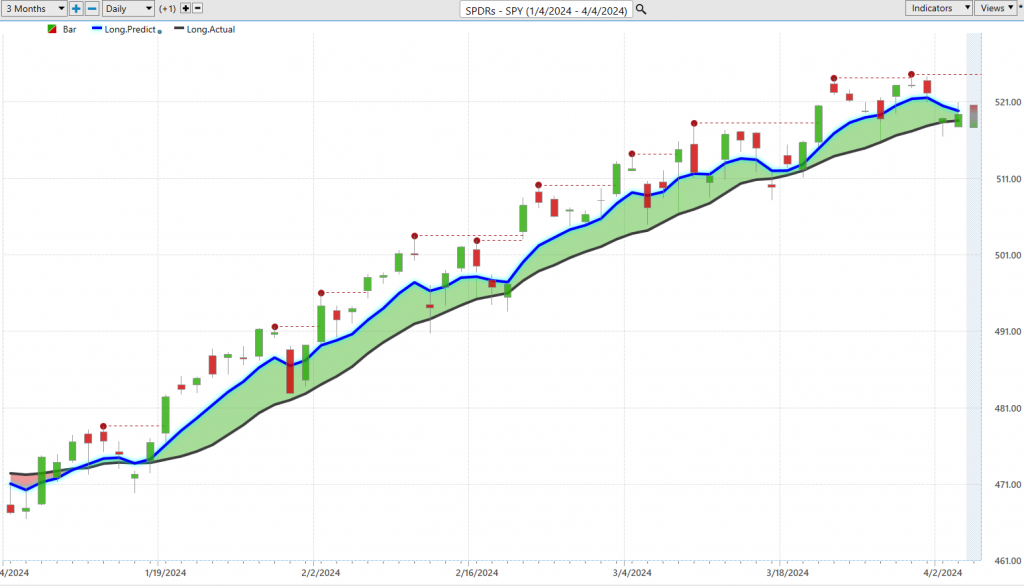
Credit spreads are designed to capture the premium difference between the two Options, which can generate income for the trader’s portfolio under the right conditions.
One of the main attractions of credit spreads is their ability to limit risk while offering a clear potential for profit. By selling an Option with a higher premium and buying an Option with a lower premium, the trader receives a net credit to their account. This credit represents the maximum profit the trader can achieve if the spread moves in their favor. The maximum risk is also predefined and is limited to the difference between the strike prices minus the net credit received. This makes credit spreads an appealing Option for traders seeking to manage their risk while aiming for consistent returns.
There are several reasons why traders should familiarize themselves with credit spreads:
- Credit spreads offer a defined risk profile, allowing traders to know their maximum potential loss upfront. This is particularly useful in volatile markets, where managing exposure is crucial.
- Credit spreads can provide a steady stream of income through the collection of premiums, which can be especially attractive in a low-yield environment or when the trader has a neutral to mildly bullish or bearish outlook on the underlying asset.
- Credit spreads can be tailored to various market conditions and forecasts. Whether a trader is bullish, bearish, or expects the market to remain relatively stable, there’s a credit spread configuration that can potentially exploit these expectations.
- Compared to other strategies, credit spreads often require less capital for entry, as the margin required is generally the maximum risk of the spread. This allows for a more efficient use of capital, enabling traders to diversify their strategies without tying up significant amounts of money.
- Credit spreads can be adjusted or rolled out to different strikes or expiration dates, giving traders flexibility in managing their positions in response to changing market conditions.
In summary, credit spreads are a valuable strategy for traders looking to generate income while maintaining control over risk. By familiarizing themselves with the nuances of credit spreads, traders can enhance their trading toolkit, enabling them to navigate various market conditions with a strategic edge. However, like all trading strategies, success with credit spreads requires a solid understanding of Options trading, meticulous risk management, and ongoing market analysis.
Let me pull you in on a little secret that’s going to change the way you look at trading forever. Picture this: a trading Masterclass that doesn’t cost you a dime but teaches you how to dance with the giants. That’s right, we’re talking about weaving the power of A.I., neural networks, and the art of intermarket analysis into your trading strategy. This isn’t just any old talk; this is about learning how to let artificial intelligence scout the battlefield for you, picking out those golden opportunities while you sip your coffee.
Now, you might be thinking, “What’s the catch?” But hear me out. We’re in an era where the small guy, yes, you are reading this, can take smart, nibble-sized chunks out of the market’s vast wealth. It’s not about the big wins; it’s the consistent hits that build your empire.
Consider this: In today’s whirlwind of a market, not arming yourself with Artificial Intelligence, Machine Learning, and Neural Networks is like stepping into a gunfight with a slingshot. A.I. doesn’t just play the game; it sees through the noise, analyzing data points by the hundreds of thousands and executing millions of calculations to spotlight where the real opportunities lie. It’s your sherpa in the Everest of trading, making sure you can tell the difference between a mirage and an oasis.
And me? Sure, I’ve got my predictions, sure. But when it comes down to brass tacks, my hunches take a backseat to what the A.I. forecasts. That’s the real juice of combining A.I. with Options trading. It’s how the big leagues, the Power Traders, scale their portfolios without breaking a sweat.
The cherry on top? This is the kind of simplicity and firepower that Vantagepoint’s A.I. brings to your daily grind. It’s about making the complex world of trading as straightforward as a Sunday morning.
So, are you hooked yet?
Dive into why artificial intelligence isn’t just a fancy tool but a cornerstone for those who play the game for keeps. It’s about slashing risks, beefing up rewards, and, let me tell you, sleeping like a baby knowing your portfolio is not just surviving but thriving.
This is how Vantagepoint artificial intelligence simplifies and empowers traders daily!
Intrigued?
Discover why artificial intelligence is the solution professional traders go to for less risk, more rewards, and guaranteed peace of mind.
Visit With US and check out the a.i. at our Next Free Live Training.
It’s not magic. It’s machine learning.
Make it count.
THERE IS A SUBSTANTIAL RISK OF LOSS ASSOCIATED WITH TRADING. ONLY RISK CAPITAL SHOULD BE USED TO TRADE. TRADING STOCKS, FUTURES, OPTIONS, FOREX, AND ETFs IS NOT SUITABLE FOR EVERYONE.IMPORTANT NOTICE!
DISCLAIMER: STOCKS, FUTURES, OPTIONS, ETFs AND CURRENCY TRADING ALL HAVE LARGE POTENTIAL REWARDS, BUT THEY ALSO HAVE LARGE POTENTIAL RISK. YOU MUST BE AWARE OF THE RISKS AND BE WILLING TO ACCEPT THEM IN ORDER TO INVEST IN THESE MARKETS. DON’T TRADE WITH MONEY YOU CAN’T AFFORD TO LOSE. THIS ARTICLE AND WEBSITE IS NEITHER A SOLICITATION NOR AN OFFER TO BUY/SELL FUTURES, OPTIONS, STOCKS, OR CURRENCIES. NO REPRESENTATION IS BEING MADE THAT ANY ACCOUNT WILL OR IS LIKELY TO ACHIEVE PROFITS OR LOSSES SIMILAR TO THOSE DISCUSSED ON THIS ARTICLE OR WEBSITE. THE PAST PERFORMANCE OF ANY TRADING SYSTEM OR METHODOLOGY IS NOT NECESSARILY INDICATIVE OF FUTURE RESULTS. CFTC RULE 4.41 – HYPOTHETICAL OR SIMULATED PERFORMANCE RESULTS HAVE CERTAIN LIMITATIONS. UNLIKE AN ACTUAL PERFORMANCE RECORD, SIMULATED RESULTS DO NOT REPRESENT ACTUAL TRADING. ALSO, SINCE THE TRADES HAVE NOT BEEN EXECUTED, THE RESULTS MAY HAVE UNDER-OR-OVER COMPENSATED FOR THE IMPACT, IF ANY, OF CERTAIN MARKET FACTORS, SUCH AS LACK OF LIQUIDITY. SIMULATED TRADING PROGRAMS IN GENERAL ARE ALSO SUBJECT TO THE FACT THAT THEY ARE DESIGNED WITH THE BENEFIT OF HINDSIGHT. NO REPRESENTATION IS BEING MADE THAT ANY ACCOUNT WILL OR IS LIKELY TO ACHIEVE PROFIT OR LOSSES SIMILAR TO THOSE SHOWN.








